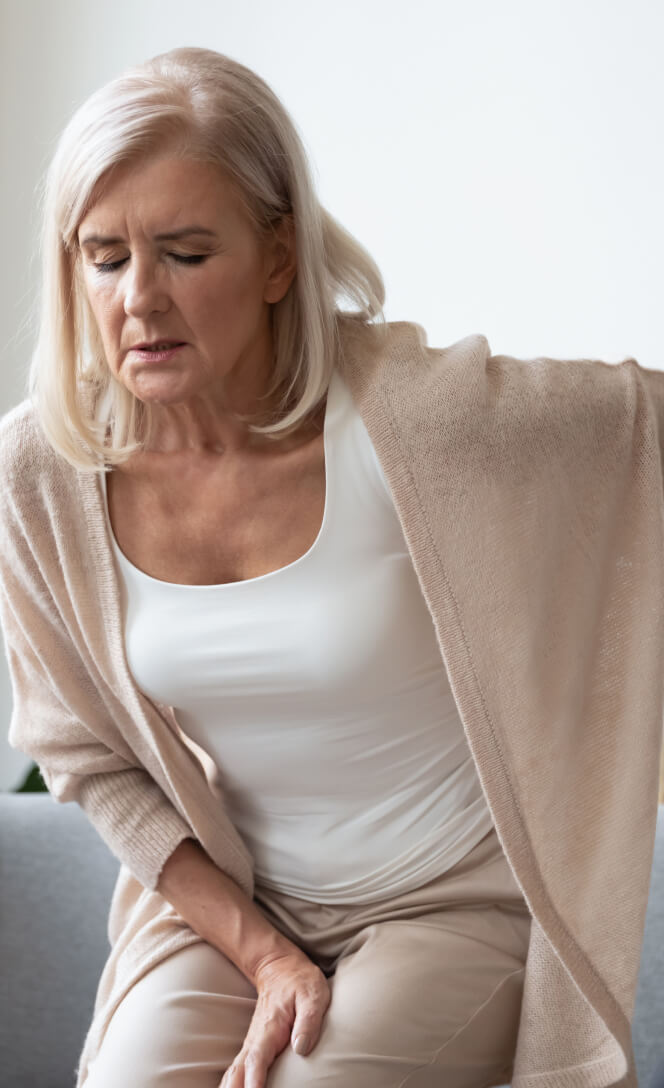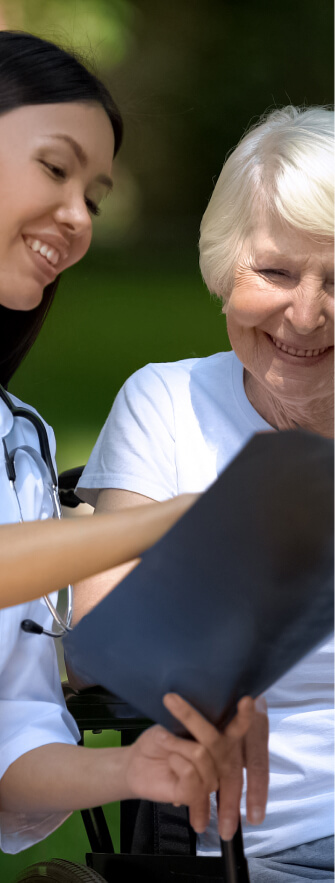
Spinal Deformities –
Adult Degenerative Scoliosis
- Degenerative Disc Disease
- Herniated Disc
- Lower Back Pain
- Neck Pain
- Sciatica (Lumbar Radiculopathy)
- Spinal Arthritis
- Spinal Deformities
- Spine Infections
- Spinal Stenosis
- Spine Trauma and Spinal Cord Injuries
- Spinal Tumors and Cancer
- Spondylosis
- Tingling in Arms (Cervical Radiculopathy)
- Upper Back Pain
The human spine is naturally balanced for optimal flexibility and support of the body’s weight.
Imbalances of the Spine: Sagittal and Scoliosis
When you look at the body from the side, the spine has three curves: the lower, lumbar spine has a curve called lordosis. The middle or thoracic spine has a curve called kyphosis. And finally, the neck or cervical spine also has a lordosis curve. These curves all work together in harmony to keep the center of gravity aligned over the hips and pelvis and keeps the spine straight.
Any spinal deformities or abnormal curvature in the spine can be seen from the side and prevent a person from standing upright, it is called sagittal imbalance. Those conditions include:
- Kyphosis: spinal deformity in which the spine curves excessively outward, creating the appearance of a hunchback. Occasionally called hyperkyphosis, to differentiate it from the normal kyphosis of the thoracic spine.
- Chin on chest syndrome: cervical and upper thoracic kyphosis that is so severe the chin drops to the chest. Also referred to as dropped head syndrome or head ptosis.
- Lordosis: a rare spinal deformity when the lower back curves excessively inward. Occasionally called hyperlordosis to differentiate it from the normal lordosis of the lumbar spine.
- Flatback syndrome: spinal deformity in which the lumbar spine loses its normal lordosis.
What is Scoliosis?
Abnormal curvature of the spine seen from the back is called scoliosis.
- Scoliosis: this deformity is the unnatural bending of the spine that can be seen when looking directly at the person’s back. Any misalignment in the spine can eventually lead to other problems in the body since the spine is an integral supportive structure and communication channel for the body.
Each of these conditions can have various causes including deformity at birth (congenital), degeneration over time due to age, diseases such as tumors or infections or causes that are not understood (idiopathic).
Scoliosis
This condition is an abnormal curvature of the spine. It most often develops in early childhood, just before a child reaches puberty.
What Are the
Causes & Forms of Scoliosis?

Scoliosis affects about 3-4 percent of the population and can impact the lives of both adolescents and adults, but it can occur at any time of life. The pain resulting from scoliosis comes in the form of sciatica and back pain and sometimes there is no obvious cause.
There are three main forms of scoliosis:
- Idiopathic Adolescent Scoliosis: This develops in adolescents typically between 10 to 18 years old. This is the most common form of scoliosis and affects roughly 4 out of every 100 adolescents.
- Degenerative Scoliosis: This is often the result of a degenerative disease of the spine and is more commonly seen in people who are over 50 years old. Diseases that contribute to degenerative scoliosis include osteoporosis, spinal stenosis, and degenerative disc disease.
- Neuromuscular Scoliosis: This tends to progress more rapidly than other forms of scoliosis and can be contributed to conditions such as muscular dystrophy or cerebral palsy.
What Are the Symptoms Associated With
Scoliosis or Sagittal Imbalance?
Visual and tactical cues are the best indicator of any spinal deformity including scoliosis. The signs can be seen or felt by someone other than the patient. Some clues include:
- Uneven shoulder or hip height
- Unusual way the arms hang beside the body
- Spine or head that is visibly off-center from the body
- Stooped forward posture
- Hump in the back
- Inability to stand up straight
- Impaired balance or a limp
Physical symptoms felt by the patient with the condition include pain ranging from mild to severe, fatigue, and muscle cramping. The stretching or compression of the spinal cord or nerves produces symptoms that may include pain, weakness, numbness, or tingling that travel down an arm or a leg. They may also have difficulty standing and sitting.
How Is Scoliosis Diagnosed?
Since the spine is easy to access, Scoliosis can be diagnosed very easily. A spine or neurosurgeon like Dr. Fayaz or even your primary care physician may ask you to bend and twist in certain directions to accurately determine any limitations of motion. If any lateral curvature of the spine is noticed, scoliosis treatment can begin quickly to reverse or treat the condition and prevent any deterioration. X-rays or MRIs may also be ordered to accurately show where the curvature is originating and to establish the extent of spinal deformity. A CT scan may also be used as a diagnostic imaging procedure in combination with X-rays and computer technology to produce detailed images of bones and soft tissues.
When Should I Consider Surgery?


Typically, non-surgical treatments such as pain medications, physical therapy and braces are typically recommended before surgery is considered to treat most spinal deformities and scoliosis. However, surgery may be considered under the following circumstances:
- The pain is severe enough that non-surgical treatments do not provide enough relief.
- It is causing compression to the spinal cord or nerves.
- The deformity is progressing and will likely continue even once growth is complete.
- The spinal deformity has progressed.
- The condition is unbearable to the patient.
- Fractures are occurring, typically caused by osteoporosis.
Since every patient’s case differs, each surgeon must determine the best surgical solution to determine the best outcome for each patient.
If the deformity has resulted in compression of the spinal cord or spinal nerves, the surgeon may perform a decompression surgery. A laminectomy is one common type of decompression surgery. In this procedure, the surgeon removes a section of bone called the lamina at the back of the vertebra. Removing the lamina provides extra space for the spinal cord and allows it to function properly.
Dr. Fayaz’s experience and knowledge allows him to determine the best way to align and stabilize the spine to achieve the most stability along with the goal of relieving symptoms. If you are in the North Houston, Conroe, The Woodlands, Spring area and believe you need to see a spine specialist for sciatica or lumbar radiculopathy, call our office at 281-880-0700 to schedule an appointment with Dr. Fayaz.